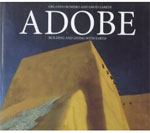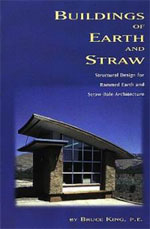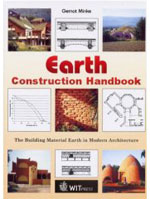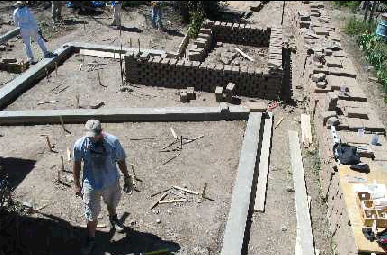La Red EcoSur y el Centro de Estudios de Construcción y Arquitectura Tropical (CECAT) de la Ciudad Universitaria José Antonio Echeverría (CUJAE), invitan a participar del Seminario Taller Sobre Construcciones con Tierra, el 11 y 12 de noviembre de 2005, como parte indisoluble de la III Conferencia Internacional de EcoMateriales 2005, y previo a ella, se desarrollará en La Habana Cuba este Seminario
Modern Earth Building 2005
The Modern Earth Building 2005 International Conference, to be held November 18 to 20 in Berlin Germany, has released the conference schedule. [ download ]
PROYECTO TERRA URUGUAY
Este Boletín de la Unidad Regional de Estudios y Gestión del Hábitat, quiere ser un lugar de encuentro entre todos los que estamos diseñando y construyendo Arquitecturas de Tierra. Vamos a dialogar con las casas de tierra que hoy se construyen en la región. Queremos pensar juntos en las posibilidades futuras de la tierra, reflexionar sobre ese patrimonio intangible del cual nos queda poco y evaluar este presente de la construcción con tierra.
Adobe: Building and Living With Earth

Adobe: Building and Living With Earth by Orlando Romero and David Larkin, is a picture-rich study of the history, technology, and dignified, sculptural beauty of adobe structures. The oldest of building materials, adobe bricks are made from mud and straw and have been used in Africa, the Iberian peninsula, and all across the Southwest and Mexico. Surprisingly durable if maintained, adobe constructions can last for centuries. Romero and Larkin explain brick-making and remudding techniques, showing both archival photographs of Native Americans at work on their pueblos and photographs of contemporary builders. They also document some of the Southwest’s most famous adobe churches and pueblos, such as the San Francisco Mission Church at Ranchos de Taos and the wondrous mesa-crowning Acoma Pueblo, as well as a selection of lesser-known buildings. Special attention is paid to interior decorative detail and to adobe’s intrinsic connection to the landscape.
Buildings of Earth and Straw

Buildings of Earth and Straw: Structural Design for Rammed Earth and Straw Bale Architecture by Bruce King chronicles the possibilities and realities of straw bale and rammed earth construction. Buildings of Earth and Straw fills in the gaps for professional builders, contractors, engineers, inspectors, lenders, and architectural students. It includes special construction requirements of earth and straw, design capabilities and limitations of these materials, and documentation of testing data for use in addressing the concerns of officials. This book offers the nuts and bolts of rammed earth and straw bale building techniques, and why they are so spectacular, durable, and earth-friendly.
The Earth Construction Handbook

The Earth Construction Handbook by Gernot Minke provides a survey of applications and construction techniques, including physical data, and explains the materials specific qualities together with the possibilities of optimising these. The information given can be practically applied by engineers, architects, builders, planners, craftsmen and laymen who wish to construct cost-effective buildings which provide a healthy, balanced indoor climate.
The Adobe Association of the Southwest
The Adobe Association of the Southwest is an organization whose mission is to
champion earth construction of yesterday, today and tomorrow.
The Adobe Alliance
The Adobe Alliance is an organization committed to building low-cost energy efficient housing that is climatically and environmentally compatible and to fill widespread needs for sustainable, salubrious housing while enhancing the unique landscape of the Big Bend region of West Texas and other desert environments through the utilization of mud-brick as a primary material in these endeavors
Vault Building Workshop
On November 4-6, 2005, The Adobe Alliance will offer an intensive vault-building workshop. The group shall be limited to 20. We will build, as usual by hand, the beginnings of a vault since it takes two weeks to complete one. The first courses are the most difficult as it is essential to master the technique of inclining the first bricks properly against the back wall which will support part of the load of the vault (most of the load descends in exquisite equilibrium into the 18″ width of the earthen brick wall.) Hands-on instruction is given by project manager/ adobera Jesusita Jimenez and theory by Simone Swan, designer.Bring work clothes, hat, gloves, heavy shoes, sun protection, a bucket, a float and water. Primitive camping available on site but without water. Lodgings are available in Presidio and Ojinaga, Mexico (across the bridge). Potluck meals at Swan House and/or Thai catering. Participants are also invited during the three weeks prior to the workshop in order to build the sustaining walls for the vaulted roof. Interns receive room and board, first come first served! If an intern wishes to join our work in plastering between November 6th and 10th, please write us. Cost is $250 by October 20, $300 thereafter. Scholarships available. Download poster (PDF)
AREA: Design + Build in Marfa, Texas

PROGRAM DATES FOR AREA SUMMER DESIGN+BUILD
June 1 – July 1 2005
AREA is a summer research+build workshop that engages a 90 year old abandoned mud-brick building, located in the town of Marfa, Texas, as the testing grounds for questioning the notion of detail, the theme of this years inquiry. Through a series of explorations that examine the process of making and unmaking in architecture, participants will design and build full-scale interventions that respond to a critical examination of place and program while addressing local/global and industrial/non-industrial agendas for architecture by employing raw earth as the primary building material in these investigations. Marfa serves as an ideal laboratory from where to study these issues. It is a town constructed almost entirely from mud-brick and transformed by rich historical, cultural and geographic forces. At 5,000 feet above sea level, it is one of the oldest cultivated areas in the United States. Located 60 miles from the U.S./Mexico border, Marfa is also home to the Chinati Foundation, an internationally renowned contemporary art museum, founded by Donald Judd, whose emphasis is on works in which art and the surrounding landscape are inextricably linked. Participants will have the opportunity to visit this extraordinary cultural and geographic landscape through a series of directed and self-guided field-studies. AREA is an initiative of the School of Architecture at Clemson University and made possible in part by the Adobe Alliance, a non-profit organization committed to the dissemination of traditional earth building technologies.
MORE INFORMATION AT: www.areainstitute.org
